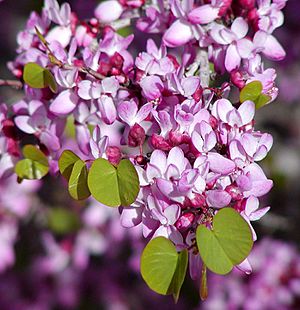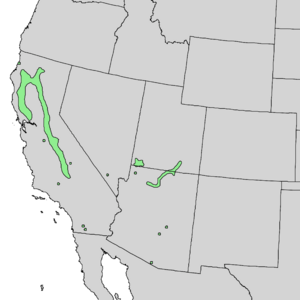Western redbud facts for kids
Quick facts for kids Western redbud |
|
|---|---|
 |
|
| Scientific classification | |
| Genus: |
Cercis
|
| Species: |
occidentalis
|
 |
|
| Natural range of Cercis occidentalis | |
The Western Redbud (also called Cercis occidentalis) is a beautiful small tree or shrub. It belongs to the legume family. You can find it growing naturally in the American Southwest. This includes places like California, Utah, and Arizona. It's easy to spot when it blooms from March to May. That's when it gets covered in pretty pink and purple flowers.
Contents
What the Western Redbud Looks Like
The Western Redbud has thin, shiny brown branches. Its leaves are shiny and shaped like hearts. They start out light green in spring. As they get older, they turn a darker green. If the plant grows in higher, cooler places, its leaves might turn gold or red in the fall.
The flowers are very bright and colorful. They are usually bright pink or magenta. These flowers grow in groups all over the shrub. This makes the plant stand out in the landscape. After the flowers, the plant grows thin, dry, brown legume pods. These pods are about 3 inches long.
How People Use Western Redbud
Traditional Uses
Long ago, Native Californians used parts of the Western Redbud. They used the flexible twigs to weave baskets. They even trimmed the shrubs. This helped new, fresh twigs grow for weaving. The bark of the plant could also give a light reddish dye. This dye was used to color the finished baskets. The Concow tribe has special names for this tree. They call it dop or tal'k in their Konkow language.
Growing Western Redbud in Gardens
The Western Redbud is also grown as an ornamental plant. This means people plant it because it looks pretty. You can see it in parks and gardens. It's also used as a street tree in some areas. Because it can handle dry weather, it's great for drought tolerant gardens. It's also popular in native plant gardens and wildlife gardens.
Images for kids



